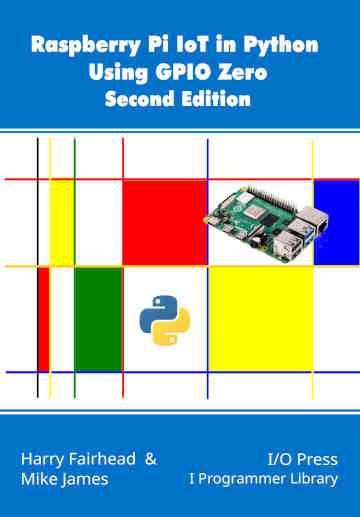| Pi IoT In Python Using GPIO Zero - Complex Input |
| Written by Harry Fairhead & Mike James | |||||||
| Monday, 18 January 2021 | |||||||
Page 3 of 3
A Custom Complex Input DeviceThe LightSensor class is more useful than it appears. As it detects the time it takes for a capacitor to discharge, it can be used to measure resistance or capacitance. If the resistor is fixed then the time depends on the value of the capacitor. If the capacitor is fixed then the time depends on the value of the resistor. Any sensor that varies its resistance or capacitance in response to external conditions can be used with the LightSensor class. For example, a thermistor is a temperature-dependent resistor and can be read using the LightSensor class. You can create a presence sensor by using a metal plate as one side of a capacitor. As people move closer or further away its capacitance changes and hence you can use it with the LightSensor class. As an example, we can create a simple moisture sensor. You need to construct two metal probes that can be stuck into the soil. The probes have to be non-corrosive and we used a pair of metal kebab skewers held in place by being passed through a plastic wire connector block, which also makes the task of connecting to the skewers easy. The block also holds the skewers apart at a fixed distance and makes putting them into the soil easier. Of course, the accuracy of measurement depends on the contact with the soil and minimization of movement. The circuit is exactly the same as for the LightSensor but with the resistor replaced by the moisture sensor:
There is no difference between this and the LightSensor, so you could just use the LightSensor class to implement the moisture sensor. However, it is easy to modify the name of LightSensor and change some of its methods: from gpiozero import LightSensor
class Moisture(LightSensor):
def __init__(self, pin=None, queue_len=5,
charge_time_limit=0.01, threshold=0.1,
partial=False, pin_factory=None):
super(Moisture, self).__init__(pin,
The only real difference is that now the resistance of the soil can be in the range 100Ω to 500KΩ, or even higher, depending on soil structure and the amount of contact and distance between the probes. You can adjust for this by changing the size of the capacitor or you can modify the charge_time_limit. For example: moisture=Moisture(4,charge_time_limit=0.5,threshold=0.6)
for d in moisture.values:
print(d)
You have to find the appropriate values of both parameters by experiment. If you have a raw sensor that works in terms of resistance or capacitance then the same procedure will produce a suitable class to work with it. HC-SR04 Distance SensorAn ultrasonic distance sensor works by sending out a pulse of ultrasonic sound and timing how long it takes to detect an echo. There are a number of similar modules on the market, but the HC-SR04 is common and inexpensive.
However, it needs to work with 5V data lines and this means using a divider to shift the voltage to 3.3V. A simpler solution is to use the HC-SR04P, which is nearly the same price and works at 3.3V. Whichever module you use, there are four connections Vcc, Ground, Trig (Trigger) and Echo. You have to connect each of Trig and Echo to a GPIO line. The basic operation is that the Trig line is set high for a short time and this causes the module to send a pulse. The Echo line goes high when a reflected pulse is detected. The time between the two events gives you the distance. The constructor requires that you specify the two pins used as the first two parameters: DistanceSensor(echo, trigger, *, queue_len=30, Notice that readings are the smoothed average of 30 measurements – ultrasonic distance measuring is very noisy. You can also specify a max_distance which is use to scale the value parameter. The threshold_distance is used to specify a “too close” event via wait_for_in_range , wait_for_out_of_range, when_in_range or when_out_of_range. The distance property gives an estimate of the current distance from 0 to max_distance and value gives a scaled distance in the range 0 to 1. In chapter but not included in this extract:
Summary
Raspberry Pi IoT In Python Using GPIO Zero
|
Konrad Zuse Born On This Day In 1910 22/06/2025 Today marks the 115th anniversary of Konrad Zuse. Although his name may not be familiar in English-speaking circles, in Germany he is known as "der Vater des Computers". He does indeed have a strong c [ ... ] |
ACM Sigmod Competition Winners Announced 20/06/2025 This year's ACM SIGMOD competition winners have been announced ahead of the annual ACM SIGMOD PODS conference which is being June 22-27, in Berlin, Germany. |
More News
|
Comments
or email your comment to: comments@i-programmer.info





